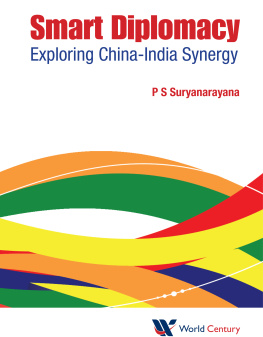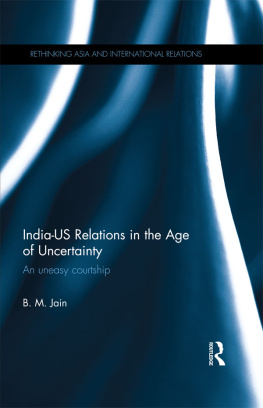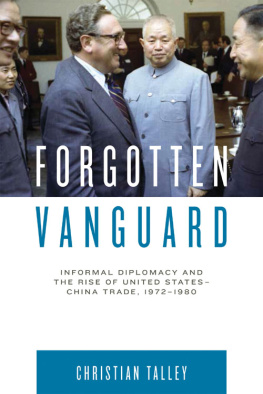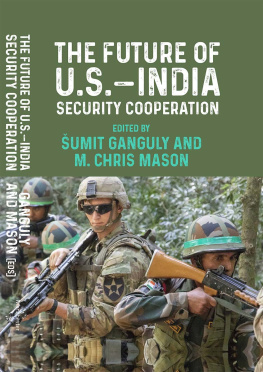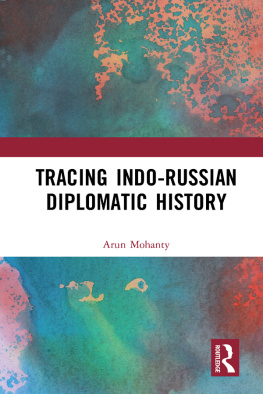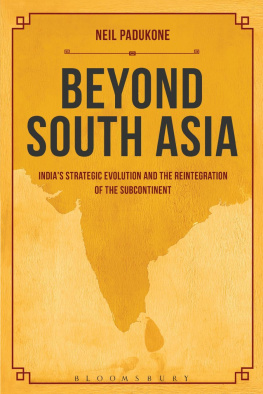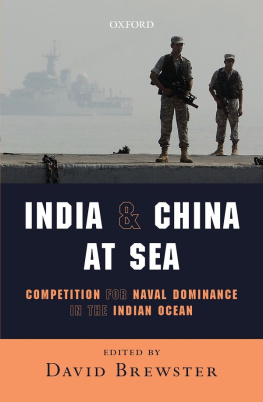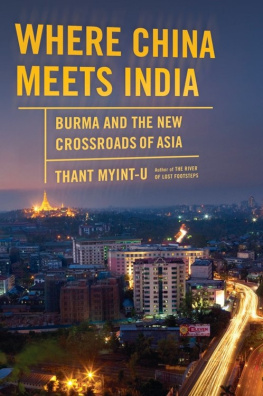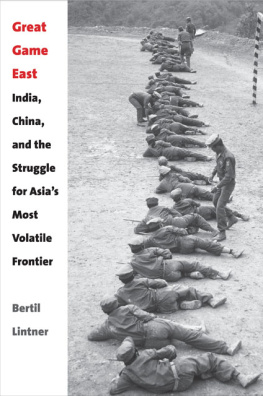Smart Diplomacy
Exploring China-India Synergy
Smart Diplomacy
Exploring China-India Synergy
P S SURYANARAYANA
Institute of South Asian Studies, NUS, Singapore
Published by
World Century Publishing Corporation
27 Warren Street, Suite 401-402, Hackensack, NJ 07601
British Library Cataloguing-in-Publication Data
A catalogue record for this book is available from the British Library.
SMART DIPLOMACY
Exploring China-India Synergy
Copyright 2016 by World Century Publishing Corporation
All rights reserved. This book, or parts thereof, may not be reproduced in any form or by any means, electronic or mechanical, including photocopying, recording or any information storage and retrieval system now known or to be invented, without written permission from the publisher.
For photocopying of material in this volume, please pay a copying fee through the Copyright Clearance Center, Inc., 222 Rosewood Drive, Danvers, MA 01923, USA. In this case permission to photocopy is not required from the publisher.
ISBN 978-1-938134-68-5
In-house Editor: Sandhya Venkatesh
Typeset by Stallion Press
Email:
Printed in Singapore
CONTENTS
FOREWORD
I thank my friend, Mr. P S Suryanarayana, for giving me the honour of contributing the foreword to this important book.
Surya, as he is known to his friends, is the Editor (Current Affairs) at the Institute of South Asian Studies (ISAS) of the National University of Singapore. Prior to joining ISAS, Surya worked for 35 years as a journalist. He was the foreign correspondent of the respected Indian newspaper, The Hindu, based in Singapore.
Surya is a learned man. He has deep knowledge of his native country, India, as well as China, Japan and the United States. He has marshalled his immense knowledge in writing this book, which is his magnum opus.
It is often said that the USChina relationship is the most important relationship in the world. I would argue that the ChinaIndia relationship is the second most important bilateral relationship in the world.
China is a continental size country, with a population of 1.3 billion and a civilization which goes back several thousand years. India is also a continental size country, with a population of 1.2 billion and an ancient civilization. Until the advent of the West, China and India accounted for almost half of the world economy.
After a long period of decline, which lasted approximately 200 years, both China and India are on the rise. Economically, China is ahead of India. However, just as Chinas economy is slowing down, Indias growth is speeding up. If the present trajectories continue and if war does not abort Asias rise, we are very likely to see a future which resembles the past. China and India will again be the two largest economies of the world.
In view of the above, the future of Sino-Indian relations is of interest, not only to the peoples of those two countries but also to Asia and the world. Will China and India live at peace with each other? Will they be able to overcome the deficit of trust between them? Will they be able to find amicable solutions to their disputes over their borders, Pakistan, Tibet, rivers, trade, etc.?
In the book, Surya has examined each of those questions. As an optimist, he has drawn the attention of the leaders of China and India to the many areas in which they share a convergence of interest, such as, international trade, climate change, anti-terrorism, maritime security, regional order, global commons, etc. In Suryas view, it would be smart diplomacy for China and India to work together and harness their synergy. I agree and hope that China and India will gradually reduce the deficit of trust between them and develop a cooperative rather than an adversarial relationship.
The two former Prime Ministers of India and China, Manmohan Singh and Wen Jiabao were right when they declared, a few years ago, that the world is big enough to accommodate a rising China and a rising India.
Tommy Koh
Ambassador-At-Large
Co-Chairman, China-Singapore Forum
Co-Chairman, India-Singapore Strategic
Dialogue
PREFACE
Space-faring and nuclear-armed China and India are proximate civilisation-states with fragile neighbourliness. Beyond this empirical reality which is a political paradox, too, a global perspective in the mid-2010s is that Asia Chinas and Indias common home is potentially the next big theatre in world affairs. It is also more than a clich that an Asian Century is possible now, only if both these countries progress rapidly at the same time at their own pace. However, they have often allowed geopolitics to determine the course of their interactions since the middle of the 20th Century. In this over-arching context, I have attempted to capture the feeble but promising signs of smart diplomacy by both China and India towards each other in the second decade of the 21st Century.
It is indeed a sign of Sino-Indian diplomatic synergy that these two mega-states have been quietly expressing political will to cooperate in specific fields of human endeavour. Despite being just a prelude to actual coordination in particular areas of interest to both countries, their diplomatic synergy, or their basic political agreement to cooperate, is in itself a novelty. To trace this story in all its complexity, a multi-dimensional analysis of the chequered relationship between China and India is inter-woven with an exposition of their diplomatic synergy.
Thinking the unthinkable, I have conceptualised the idea of a ChinaIndia Smart Zone as a shared mindscape that might become a post-modern sequel to the old geo-cultural Indo-china, the two being completely distinctive, though. A starting-point, different from the actual basis, for this discussion is the emerging new normal of national-power benchmarks in China, evident in the mid-2010s, and the parallel sign of an upwardlystabilising India.
The book is structured as an integral framework of stand-alone thematic chapters with seamless continuity of thought. China and India are first projected as Sunrise Powers of the Twenty-First Century in the light of the possibility of their futurist Smart Zone, and the potential for their synergies in some areas. This is followed by a discussion of the ideologies that shaped the evolution of these two countries from their inception as sovereign states in their present avatars. Next, in a logical take-off, their core interests and concerns are analysed. Having thus profiled the two countries as plenipotentiary states with competitive aspirations, I shift the focus to an emerging Asian Arc of Power Politics in the subsequent chapter. A further search for ChinaIndia synergies is made in this Arc of Power Politics. This sets the stage for a discussion, in the next two chapters, on how India and China have struck a purple patch of all-weather dialogue in the mid-2010s, and how the two countries are talking the walk towards an uncharted future.
Hopefully, the three annexes consisting of interviews on Chinas perspective on India, Indias perspective on China, and an internationalist perspective serve as a delicious journalistic icing on the cake of probing diplomatic research. In sum, the book is only an introductory study of the possibilities in ChinaIndia relations, going forward.

